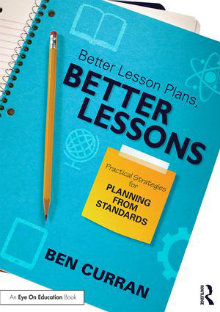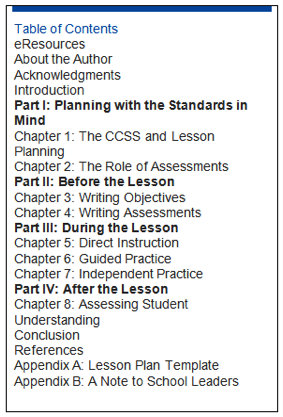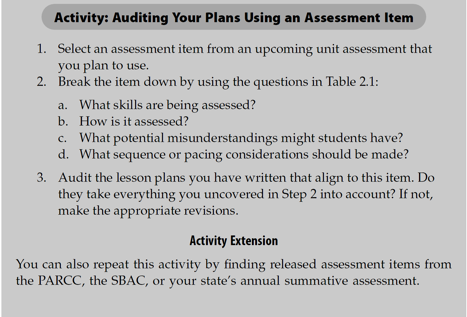How to Write Better Lesson Plans
Better Lesson Plans, Better Lessons: Practical Strategies for Planning from Standards
By Ben Curran
(Routledge/Eye on Education, 2017 – Learn more)

Lesson planning! Two simple words that evoke a variety of reactions in a teacher’s mind. Worry. Agony. Pride. Wondering. Data. Observations. Staying up late to complete them. Sound familiar?

But most of the teachers I have talked with view lesson plans as the map they use to show them what their students need to learn and how to get there effectively. It’s the glue that holds the pieces of the education puzzle together. It’s a shareable product they use to ensure that their students are learning and succeeding.
I remember my first attempts at writing lesson plans. I also remember the mistakes I made. Now I wish I could go back in time and repair my mistakes. The truth is that I wish that this book had been required reading when I first started my teaching career. To be a teacher, you need to know how to do many tasks, and writing effective lesson plans is on the top of the list.
Beyond the usual to-do list
As Ben Curran demonstrates throughout the book, Better Lesson Plans, Better Lessons: Practical Strategies for Planning From Standards, lesson planning is more than citing CCSS, writing objectives, providing worksheets and activities to complete, or using a “one size fits all” assessment at the end of a unit.
Instead, it is a deliberate, on-going practice that is built with precision and thought. Lesson planning is definitively a reflective practice, and this books helps YOU, the reader, write better lesson plans and in turn, become an even better teacher than you presently are.
It’s simple. Research shows that student learning is correlated to teacher planning. Curran, a former classroom teacher and instructional coach, is the expert guide who walks the reader through the process of writing the best lesson plans.
What you will find

The final section of the book is the “So what now…” section. What happens if your students “don’t get it”? What about “reaching high achieving students”? Where do I go from here? My lesson plans are written, now what!
As a veteran teacher I am always open to and get excited about learning, as most teachers do. My toolbox is expandable and I carry it wherever I go. I can always fit in another tool to make my students’ learning more authentic and memorable. That’s why I adore this book.
An easy-to-use future classic
It is a book that will not lose its impact with time or any new educational buzz word. In fact, I’d predict that this book will become something of a classic and will be used in colleges and universities as a mentor guide for new and veteran teachers.
It’s not a long book (110 pp.) Curran’s text is straightforward, easy to read, and practical. It was written with reflection and collaboration in mind. It is also written with the busy teacher in mind. I guarantee that after reading this book and applying his ideas and practices to your own teaching, you will feel you are a better teacher than you are right now. Are you ready for the challenge?
For example, Curran cautions that writing objectives is more than copying an objective from the book. It is built on four things: being measurable, bite-sized, clear, and aligned. Curran tells it like it is.
The best lessons start with a single sentence. A learning objective, sometimes called a learning target or aim, it’s the sentence that clearly and succinctly describes what student will be able to do at the end of the lesson…Writing a strong objective may seem like a fairly straightforward task, but it takes a great deal of thought and care.” (p.31)
I found myself reading a chapter at a time, taking time to digest it, rereading it, and then sharing what I learned with my colleagues. The FAQ section of each chapter addresses questions that frequently arise, and the “teacher activity” at the end of each chapter is realistic, authentic, and most importantly, “doable.”

Copyrighted material
Curran recognizes the pressures that teachers face and is quite candid about it. He cautions the teacher that “planning should never require so much of your energy that it takes away from your ability – including your patience, flexibility, and determination – to deliver an effective lesson.” (p. 99)
For pre-service teachers and vets alike
In the past I have mentored student teachers in my school district. Since writing lesson plans was relatively new to them, it was an area that they usually had the most difficulty with. Writing a lesson plan in your pre-service college classroom was one thing, but writing a lesson plan that was going to positively impact over 20 young students was completely another thing. This book is definitely useful for all pre-service teachers. I would purchase the book as a “welcome gift” to any student teacher I may work with in the future.
If you are a cooperating teacher, professor, or supervisor of student teachers, I would recommend this book for required reading and discussion. If you are a school leader, I recommend this book as part of a PLC experience. If you are a classroom teacher, I recommend that you read this book. It will change how you approach writing lessons plans.
I haven’t found anything better than this. As an extra bonus, many of the tools from the book are also available as free downloads from the companion website. Happy lesson planning. Thank you, Ben Curran!
Linda Biondi is a fourth grade teacher at Sharon Elementary School in Robbinsville, NJ and a long-time Morning Meeting practitioner. She’s also the recipient of several educational grants, a Teacher Consultant with the National Writing Project, and a participant on the NJ Department of Education Teacher Advisory Panel and with ECET2 Celebrate Teaching.



































Linda, thanks for this review. I would definitely recommend this book to teachers. I particularly like the straight-forward definition of an instructional objective.